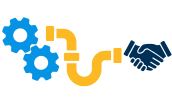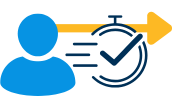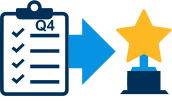New year, new you. We hear that phrase frequently now that it is the beginning of a new year. Beyond resolutions to exercise more or drink more water, according to a recent survey, 85% of US workers plan to set career goals for 2025. This year, we are all about expanding our professional network. A strong network supports your professional goals and provides a safety net of resources and opportunities. Not sure where to begin expanding your network? Let’s review ten actionable steps to help you broaden your professional horizons in the year ahead.
Leverage Social Media Platforms
In today’s digital era, social media is more than just a space for casual interaction; it is a dynamic tool for professional networking. Platforms like LinkedIn and X are invaluable for connecting with industry peers, sharing pertinent content, and engaging in thought leadership discussions. Start leveraging social media by updating your profile information, including your professional photo, and creating an engaging summary of your skills and interests. Once you have updated your profile, post content reflecting your industry expertise. Content such as industry trends and personal reflections on recent projects can allow you to engage with your audience. Beyond posting your own original content, comment on posts by industry leaders and peers. Join relevant groups and actively participate in discussions. These interactions will increase your visibility and position you as an informed professional.
Participate in Virtual Events
The shift towards virtual networking is not just a temporary adaptation. In 2025, virtual events like webinars, online conferences, and virtual meetups will continue to offer you access to global industry leaders. When attending a virtual event, research speakers and attendees before the event. Participate in breakout sessions and use chat features to introduce yourself. Remember to contribute thoughtfully to the chat. When the event is over, event coordinators usually furnish an attendee list. Use the list to send personalized follow-up messages to speakers and fellow participants to solidify your connections.
Join Professional Associations
Becoming part of relevant professional associations can boost your networking efforts. These organizations provide a structured environment for networking through events, workshops, and forums aimed at member interaction. Research associations that align with your career goals and interests. Contribute to events rather than simply attending. Get involved in committees or take on a leadership role, demonstrating you are a dedicated industry professional and increasing the likelihood of interaction with influential figures in your field.
Use Networking Apps
Apps like Lunchclub, Bumble Bizz, and Shapr facilitate meaningful connections based on shared interests and professional goals. Set up a profile that accurately reflects your skills and aspirations. Engage with those who have matched profiles and take the initiative to arrange meetings, either virtual or in-person. Do not underestimate the power of building relationships through these innovative tools.
Engage in Community Service
Volunteering offers a double benefit, improving your community and broadening your professional network. Identify local charities or projects that resonate with you professionally or personally. Volunteer your skills and time to these causes. Community service projects often attract diverse groups of people, providing a valuable opportunity to network outside of your close professional circle, and an opportunity for exposure to new perspectives and potential collaborations.
Host or Attend Events
Taking the initiative to host events can significantly boost your networking efforts. Whether you organize workshops, webinars, or meetups, being a host positions you as a proactive leader in your field. Plan your events around topics that are currently trending or relevant to your industry to attract other professionals who share similar interests or challenges.
If hosting an event seems daunting, be an engaging participant in events you attend. Introduce yourself to organizers and speakers and take part in meaningful conversations, offering insights when appropriate. Networking at events is about giving value and receiving value.
Cultivate Relationships with Alumni
Your university alumni network is often a goldmine of shared experiences and opportunities. Alumni networks offer a natural advantage as shared educational backgrounds and experiences provide common ground for building professional relationships. Attend alumni events. Participants at alumni events represent a diverse array of industries opening a world of opportunities.
Create and Share Valuable Content
Demonstrating your expertise through content creation is an effective networking strategy. Digital content, such as articles, blogs, and videos, continues to be a powerful way to engage with fellow professionals. Begin by identifying topics you are enthusiastic about. Publish content regularly to build a following. Engaging content that attracts peer and industry recognition often sparks networking opportunities.
Mentor or Become a Mentee
Mentorship is a two-way street that benefits both parties. Whether you choose to mentor someone or seek out a mentor, the process will expand your network. As a mentor, you should invest in the professional growth of your mentee by providing guidance and sharing experience. As a mentee, you gain access to knowledge and industry insights to fuel your career advancement. A mentor’s support can open doors to new opportunities and more influential contacts.
As you set your sights on expanding your professional network in 2025, remember that success often lies in leveraging the right opportunities and connections. Whether you are building relationships through social media, attending events, or joining professional associations, each step advances you toward achieving your career aspirations. Ready to take the next step in your career? Let’s make 2025 your breakout year. Contact Peoplelink today and let us help you level up your career!



























